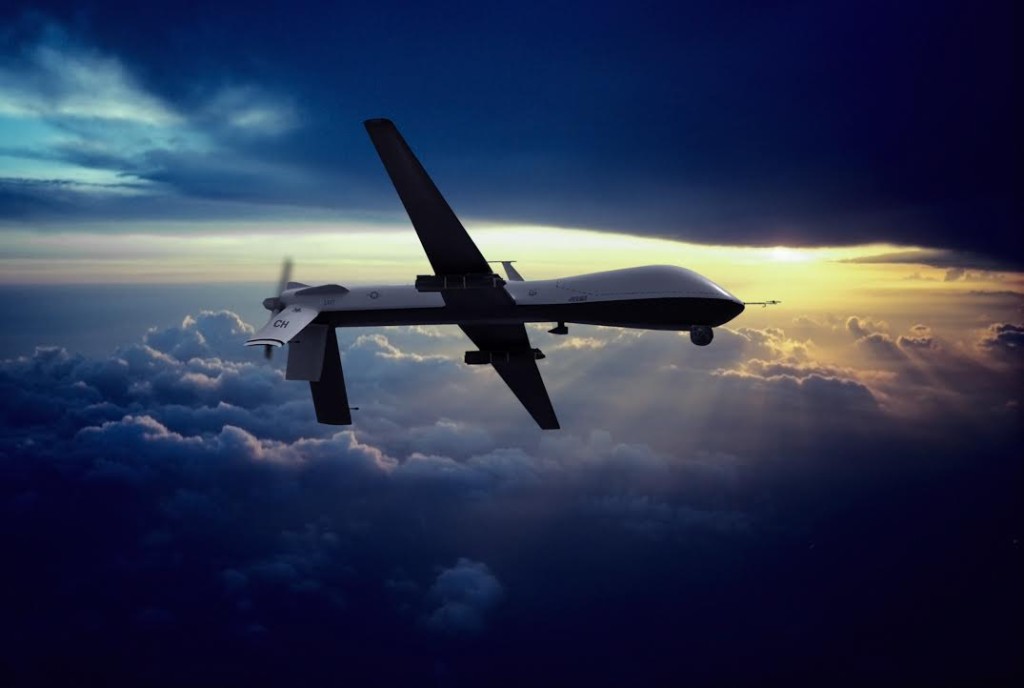Flying Through the Fog of War

MQ-1 Predator Flying at Sunset. Picture by Erik Simonsen | Getty Images

The Legal Debate on the U.S. Drone Program and Why it Matters to U.S. Interests
On Thursday, the White House released a statement disclosing that U.S. citizen Warren Weinstein and Italian citizen Giovanni Lo Porto were killed in an American drone strike carried out earlier this year. The White House referenced the “uniquely tragic nature” of the incident but stated that the strike “was lawful and conducted consistent with our counterterrorism policies,” though both its exceptionality and lawfulness will be subject to debate in the coming days.
American foreign policy seldom obtains consensus, and there is no exception for the government’s use of unmanned aerial vehicles (UAVs) to target suspected terrorists. Use of UAVs or “drones” dates back to World War II, but their newfound controversy stems from their 21st century role in the U.S. counterterrorism strategy. While UAV usage to combat terrorism has received general support in the domestic realm, opinions differ overseas—markedly so. One reason for this disparity may be evident: countries tend not to support a technology they do not have. But a more fundamental and troubling cause of this dichotomy lies in contrasting interpretations of applicable international law.
The majority of Americans support UAV strikes. Two wars in the Middle East have killed and maimed thousands of men and women in the U.S. armed forces. It is unsurprising that the domestic public would support the use of technology that could prevent death and injury to American troops. Drones are also relatively cost-effective, generally possess greater precision capabilities than alternative weaponry, and have damaged al-Qaeda’s leadership, and are thus in many ways a sensible component of counterterrorism efforts.
Yet it is also sensible that other countries are concerned with U.S. UAV operations. They challenge a broad international legal framework developed over the course of a century, and the opacity of the U.S. UAV program is legitimately troubling. The long-term implications of the U.S. drone program—its capacity to alienate communities, to contribute to the proliferation of terrorist activity, or to weaken relationships with allies—are under-researched, yet of tremendous importance to U.S. interests.
Regulatory gaps emerge when our laws do not keep pace with advances in technology. But to close such gaps requires an earnest public discussion on the roles we want technology to serve in our society. This article explores some of the boundaries—and lack thereof—in a complex realm of 21st century warfare. Transnational security threats are shifting the technological and legal landscapes. What do these shifts mean to U.S. interests and policy?
Debated Legality of the U.S. Drone Program
The international framework that governs the methods of warfare is comprised of bilateral and multilateral treaties, peremptory norms and international custom developed by historical observance of rulings and principles. Readers may be familiar with the Hague Conventions of 1899 and 1907, the Geneva Conventions of 1949, along with humanitarian laws of jus ad bellum (law governing the resort to force), jus in bello (law regulating the conduct of military operations during war) and international human rights law (IHRL), all of which have been codified in multilateral treaties and other documents. Development of this framework gained momentum following World Wars I and II, and within them, events that disturbed the global conscience.
The United States led the development of this framework. In the wake of both world wars, U.S. leadership recognized the implications of global insecurity on national welfare. The country’s role in the evolution of international law is an important part of U.S. history, and U.S. identity. But realist theory predicts—and history demonstrates—the habit of dominant countries to reinterpret elements of the law to further national interests. The United States is no exception. U.S. UAV usage is merely one out of many practices (and wars) that have been “justified” through strained legal interpretations.
Today, there is no shortage of legal analysis on U.S. drone operations. It is beyond the scope of this article to sufficiently address this body of literature, but exploration of this material is recommended. The legal propriety of UAV operations has been the subject of numerous examinations, including a UN Human Rights Council expert panel, a study by Columbia Law School’s Human Rights Clinic and a joint study conducted by the Stanford Law School and the Global Justice Clinic at the New York University School of Law. It is the topic of a 238-page report by the New York City Bar, and was central theme of ACLU-led litigation (Al-Awlaki v. Panetta).
UAV operations in foreign territories have the potential to violate that foreign state’s sovereignty (Article 2(4) of the U.N. Charter). This generally does not pose a challenge for U.S. drone operations because the U.S. seeks and receives consent from states where operations take place, such as Yemen and Pakistan. Without consent, the activity must qualify as an “act of self-defense” (Article 51 of the UN Charter). But the U.S. has developed a controversial interpretation of Article 51 that is generally rejected by the international community, and that has enhanced an already inherent tension between Article 2(4) and Article 51.[1]
There is further debate over whether targeted killings are extrajudicial, occurring outside of the judicial or legal process and unlawful if committed against noncombatants (this has also raised domestic concerns over the constitutional right to due process for targeted U.S. citizens). Whether the operations take place within or outside of conflict determines the laws that apply; the geography of U.S. counterterrorism and who is considered a “combatant” add dimensions of complexity to the matter. A congressional statute, the 2001 Authorization for Use of Military Force (AUMF), permits drone operations against al-Qaeda and its “affiliates.” It is here where the lines of conflict have blurred. The statute’s scope is not clearly delineated, but make no mistake: the ambiguity is intentional.
Other analyses examine whether UAV operations may violate humanitarian principles of military necessity, distinction, and proportionality.[2] Distinction forbids direct and intentional targeting of noncombatants, while proportionality, as outlined in Protocol II of the Geneva Conventions, “requires that parties refrain from attacks in which the expected civilian casualties will be excessive in relation to the anticipated military advantage gained.”[3] The latter is central to debates on civilian casualties but also whether drones’ precision capabilities bring such operations further in line with the proportionality principle than alternative weaponry.
The point of this discussion is not to reach a determination on the legality of the U.S. drone program, but to highlight the intense complexity of the subject itself, and the importance of a dialogue to understand what our society seeks in terms of standards for UAV operations. Terrorism and the technology to combat it have challenged the fundamental conceptions of “conflict,” “combatant,” and where the geographical lines of the fight are drawn. Terrorists “do not have a strict territorial nexus to any particular state,” explains law professor Milena Sterio, and “thus interject[] a layer of complexity into the definition of a battle field.”[4] This poses a challenge that has been met by technological advancements, but not fully accommodated for by the existing international legal framework. This framework, pioneered and supported by the United States, has yet to evolve with the emergence of transnational threats, and the realities of a globalized world.
Why This Matters to U.S. Interests
An absence of enforcement mechanisms exposes international law to frequent pessimism. And a legal debate on U.S. drone operations is not anomalous to counterterrorism practices of the post-9/11 era. So why should the legal propriety of UAV operations matter to the United States? It may matter not for potential near-term losses, but rather for important opportunities forgone.
The United States forsakes the opportunity to set a precedent. As UAV technology advances in other countries, it is likely that their usage—and public support—will increase (this may already be happening in Europe). A globalized, interconnected world necessitates U.S. concern for how this technology is implemented overseas. In Foreign Affairs, Daniel Byman asserts that the U.S. must spell out “clearer rules for extrajudicial and extraterritorial killings so that tyrannical regimes will have a harder time pointing to the U.S. drone program to justify attacks against political opponents.” The United States has served as a key player in the development of the applicable normative framework—the very regulatory mechanisms which are now relevant to UAV operations. A disregard or, in this case, a strained interpretation of the applicable laws serves to undermine normative foundations that the United States worked to build for decades, and relinquishes an opportunity that could serve to confirm the United States’ leadership role.
The U.S. further relinquishes an opportunity to bolster U.S. reputation, though the value of this opportunity is subject to fair debate. Indeed, the U.S. turns down many of these “opportunities” (think Rome Statute, Kyoto Protocol, Convention on the Rights of the Child). Martin Flaherty posits that “adherence to international law is critical to leverage support from allies and the international community in an era of overstretched military commitments and reduced defense budgets.”[5] But the relationship between reputation and international law is one of complexity, as examined at length by George W. Downs and Michael A. Jones. Downs and Jones find that reputation may not hold the significance that other scholars have attributed to it. Reputational concerns are, understandably, not at the forefront of U.S. counterterrorism strategy. Ultimately, law professor Andrew Guzman is correct in that “[e]very factor that a state considers operates at the margin, and reputation is no different.”
But because reputation is not the primary concern does not mean it is of no concern at all. In fact, it would appear that reputational concerns have garnered sustained attention by the Obama administration—most recently in the President’s apology for the deaths of Mr. Weinstein and Mr. Lo Porto. But this also appears in the extensive measures taken to arrive at interpretations that will comply with international law, along with declarations of these interpretations as adequate by Harold Koh, Eric Holder, and the President himself. Indeed, the Obama administration seems to have acknowledged the legal and political tensions derived from drone operations, and this is perhaps demonstrated in a 2013 policy shift towards marginally improved transparency and limited targets.[6]
But more urgent to national security interests, the U.S. may jeopardize the opportunity to make long-term impacts on transnational terrorism. The legality of U.S. drone operations matters because the long-term implications of drone warfare are not known. Evidence suggests that over time, UAV operations have had an effect on al-Qaeda forces. But what kind of effect will it have on terrorism generally? It is in the interests of the United States to not just impede terrorist activity in the short term, but to also not contribute to its proliferation, and to at best eradicate it. What impact does the U.S. drone program have in the areas in which it operates: does it alienate large swaths of the population? Does it generate resentment that culminates in terrorist activity? Do questions of legality and civilian casualties affect the willingness of states to support U.S. counterterrorism efforts? Such support is essential to a problem that transcends state borders. These are critical questions to U.S. interests, and they rely first and foremost on accurate information about the U.S. drone program.
Step One: Information
A genuine dialogue on the U.S. drone program is precluded by a dearth of reliable information—this is the heart of the matter. Data on casualties from UAV strikes varies in part due to the difficulty of collecting such information reliably, but also due to the manipulation of data, a product of political motivations on both sides. Estimates of UAV civilian casualties range from not “a single collateral death” from June 2010 to June 2011 (by CIA Director John Brennan), to numbers in the thousands over the course of the U.S. drone program, as reported by multiple NGOs. A report by the Brookings Institution estimates that ten civilians were killed for every terrorist. Who is considered a “militant” transforms the estimates dramatically: the Obama administration has classified all military-aged males is a strike zone as such; in contrast, a Pakistani court at one point counted livestock and cattle in the calculation of “civilian casualties.”[7]
One consistency is that independent investigations into civilian casualties come back with numbers higher than the U.S. government reports. This discrepancy ultimately obstructs an earnest discussion on the legality and future of drone warfare. Calls for transparency and publication of data have swelled within and outside of academia, and will likely continue in the wake of the deaths of Mr. Weinstein and Mr. Lo Porto (worthwhile reading includes a recent article in which Allen Buchanan and Robert Keohane propose the “Drone Accountability Regime”).[8]
Looking Forward
Scholars and practitioners alike seek to wholly determine the legality of UAV operations, yet this analysis finds that it may be neither possible nor advisable to do so in the absence of reliable data on practices, and a legal framework that cannot fully accommodate for the complex qualities of transnational terrorism. We should resist the tendency to polarize on an issue that needs an earnest public debate, and needs the inclusion of the U.S. government in that debate. Such a conversation must pose questions on the United States’ role in the use of new technologies, but also in the development of standards for their use.
The laws of war were constructed from some of the darkest moments of the 20th century. In this next century, they remain a key component of international affairs and this will not change. Yet how they fill this role in the 21st century can and should change. Many of the applicable laws were created and codified in an era that did not know terrorism in its present form. Domestic and international laws must develop to adequately acknowledge the changing geography of security threats, and the distinct challenges of transnational problems. Yet they must also protect the moral principles upon which they were founded, and protect the rights of the world’s citizenry as they were intended.
But who will lead such an endeavor? Rather than positing strained legal interpretations and withholding valuable data, the United States could contribute to the evolution of international law to accommodate the stark realities of transnational security threats and technological advancement. The U.S. could again serve as the leader it once was in defining the ethics and laws of warfare. This leadership will begin with greater transparency, accountability and a forthright dialogue on what exactly has happened in the U.S. drone program.
[1] This interpretation proclaims three validations for an act of self-defense: in the event of an armed attack, in the event of an imminent threat where “the necessity of that threat is instant, overwhelming, and leaving no choice of means, and no moment of deliberation”; and finally, as defense against a “continuing threat.”
[2] Nasser, Tony. 2015. “Modern War Crimes by the United States: Do Drone Strikes Violate International Law? Questioning the Legality of U.S. Drone Strikes and Analyzing the United States’ Response to International Reproach Based on the Realism Theory of International Relations.” Southern California Interdisciplinary Law Journal 24, 289. Page 303.
[3] Protocol Additional to the Geneva Conventions of 12 August 1949, and relating to the Protection of Victims of Non-International Armed Conflicts (Protocol II), 8 June 1977. It should be noted that while the Protocol has 183 state parties, the United States, along with Iran and Pakistan, has signed but not ratified Protocol II.
[4] Sterio, Milena. 2015. “The Covert Use of Drones: How Secrecy Undermines Oversight and Accountability.” Albany Government Law Review 8, no. 1: 129-165.
[5] Flaherty, Martin S. 2015. “The Constitution Follows the Drone: Targeted Killings, Legal Constraints, and Judicial Safeguards.” Harvard Journal Of Law & Public Policy 38, no. 1: 21-42.
[6] It should be noted that the “capture over kill” movement appears to have gained momentum; indeed, just last week Mohanad Mahmoud Al Farekh stood before a judge in Brooklyn, New York. Despite being located multiple times by drones in 2013, Mr. Farekh was instead apprehended last year. It is further noteworthy that drone strikes are in decline, though whether this is due to international pressure or a waning pool of prospective targets (or both) is subject to debate.
[7] Ross, Alice K. 2013. “The Legality of War: Pakistani Court Rules CIA Drone Strikes Constitute a War Crime?” Global Research. (May 11, 2013).
[8] Buchanan, Allen, and Robert O. Keohane. 2015. “Toward a Drone Accountability Regime.” Ethics & International Affairs (Cambridge University Press) 29, no. 1: 15-37.
Madeleine is a second-year M.A. student at New York University. She graduated summa cum laude from the State University of New York at Purchase, with a B.A. in political science and a minor in economics. She is currently working as a legal assistant for a firm in New York. Previously, Madeleine served as an editor for the Center for Constitutional Transitions at NYU Law School, and as an editorial intern for the Carnegie Council for Ethics in International Affairs. Her research interests include multilateral intervention in intrastate conflict, creation and evolution of international norms, and the role of global governance mechanisms in influencing development outcomes.







1 thought on “Flying Through the Fog of War”